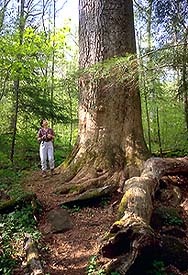By the 1920s, time was running out for the virgin woods of Little Santeelah Creek. The saws had begun singing in the neighboring valley of Slickrock Creek years earlier. The Babcock Land and Timber Company was harvesting the sugar maple, tulip and other valuable trees, then floating them down to a rail line along the Little Tennessee River.
With half the Slickrock valley logged out and the railroad about to be flooded by the damming of the Little Tennessee, the company began surveying adjacent lands, searching for the next valley in which to bring its axes and lumbermen. Little Santeelah lay just over a ridge to the east. But the lumbermen looked west, where Citico Creek drained a vast unblemished forest. Citico occupied the saws for awhile, until a huge fire swept through thousands of acres and destroyed the centuries-old stands that had brought the timbermen into the valley. Once again, they moved on to another watershed.
By the early thirties, the Little Santeelah forest was an isolated island in a sea of cleared lands. Inevitably it fell under the gaze of the lumbermen, but each time they moved into the valley, its huge yellow poplars and chestnuts filled them with awe. Some mysterious protection prevented them from swinging the axes. The land exchanged hands several times, each owner eager to gain the riches from felling the giant hardwoods that towered over the stream. But whether because of a lumberman's respect for nature's mightiest, the financial hardship enveloping the country, or an unknown force diverting all encroachers, the blades never cut.
In 1935, anxious to find a suitable tribute for a fallen hero whose poem "Trees" had inspired millions, the Forest Service inaugurated the Little Santeelah as the Joyce Kilmer Memorial Forest. Nature's centuries-old masterpiece would be protected for generations into the future.

|

